
 |
For the last few weeks my friends and I had been chatting about a return trip to Fanad Head Lighthouse for a night shoot, after all, the dark season is here and we are in that transition zone between late Summer and early Autumn, a time of year which greatly favors capturing the Milky Way. In fact from August all through to September is a superb time for observing and photographing the southern sectors of our galaxy, it's these regions which are closer to the galactic centre and which offer rich star numbers and structure. The Milky Way is technically visible from our country all year long however it's the lower sections between Scutum, Scorpious, and Sagittarius which are only visible above the horizon for a specific time in the evening sky so these constellations do require some degree of planning and moon dodging.
Friday night September 4th 2024 was forecast to be clear, however the models did indicate cloud moving in around 03.00 from the NW which still left many hours of clear skies. The moon was absent, the wind would be a very light Nly and with warm temperatures that day expecting to remain into nightfall it looked to be a muggy night under the stars with GFS showing temps of 18c at midnight. I was fully planning either a telescopic night or photo shoot anyway, likely within the Sperrins, however in the back of my mind I was wondering if Paul Martin was game for a shoot, maybe somewhere different. I had no sooner thought this when I got a message from Paul Martin, he was not only up for a shoot but was considering going to Fanad Head in Co. Donegal and asked if I was up for it. I was, in fact, I was mad looking to get back there for another adventure.
A plan was arranged, my other friends couldn't make it for one reason or another so it looked to be just Paul and I, actually three of us as my Dog Rhua would be coming with us too. This would be our third night shoot to Fanad. Our First was during September 27th 2014, that night we visited Dunlewey Church then shot the lighthouse. We even got into the grounds and captured the lighthouse filling the frame at wide angle with star trails, it was a brilliant night. Our next visit was in September 20th 2019 when Nigel McFarland joined us. We had arrived at sunset and managed to get drone footage of the area followed by a moonlit shoot of the lighthouse and abandoned buildings, yet another great experience.
This time there would be some limitations, the lighthouse is now one of three accommodations to rent for the night, so you can actually stay over inside the old lighthouse keepers cottages and inside the lighthouse itself, how awesome would that be. I checked online and found out the entire place was booked out tonight so this meant people would be staying over. This presented a problem, there could be extra lights and it meant we could no longer get up close to the lighthouse to replicate that wide angle Milky Way shot we wanted. In truth the gates are locked and the grounds are private so we could only shoot from further way on the headland. Either way we would find out later and we would learn from this trip for the future, after all, location scouting is just as important as the shoot itself.
The late afternoon was very warm with intense sunshine, Rhua was warm in the front seat, I had both windows down, it felt for once like a proper Summer's day with blazing sunshine and blue skies. The van was reading +28c however official weather stations recorded +27c, no one was complaining. We met Paul in Omagh at 18.00 then transferred all my gear into his van then we made our way NW for Donegal. The roads were busy but Paul done a great job of taking back routes to avoid the worst of it. While on the way Paul said he had another location in mind at Mulroy Bay approximately 20 min's before Fanad where he had found wrecked fishing boats on shore which could be worth checking out for a shoot so we planned to stop there first.
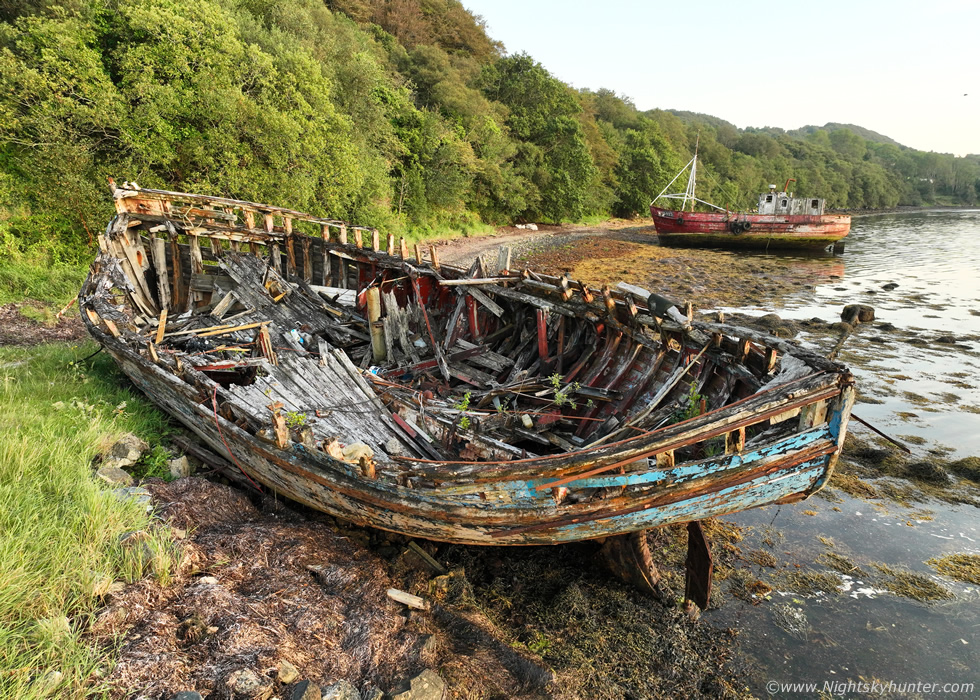 |
We arrived at Mulroy Bay literally before sunset and got out for a recce. We loved the boats, they where literally sitting on shore in shallow water, easy to walk to, could these work for a night shoot?, we got the drones in the air and took footage and images for the record.
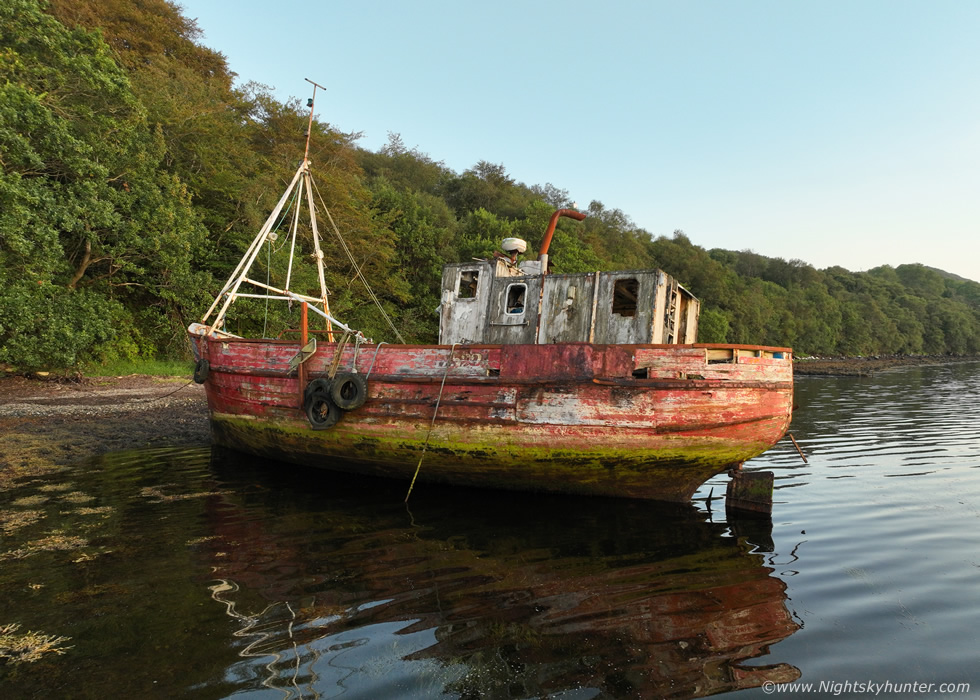 |
The old red fishing boat is called Sabrina and she became our obvious choice, there's something about old derelict boats and ship wrecks, they are perfect foreground for the night sky. Paul and I studied everything here, this angle would be facing where the Milky Way would be after dark, the other side was even better looking and faced N for star trails and aurora, we decided Sabrina could become the focus of our night and could potentially upstage the lighthouse. The only problem was the tide was preventing us from getting up close and filling the wide angle frame so we checked tide times, low tide at Mulroy Bay was 02.20 approx, this looked promising, later in the night we would be able to walk out and get up close and personal with the boat.
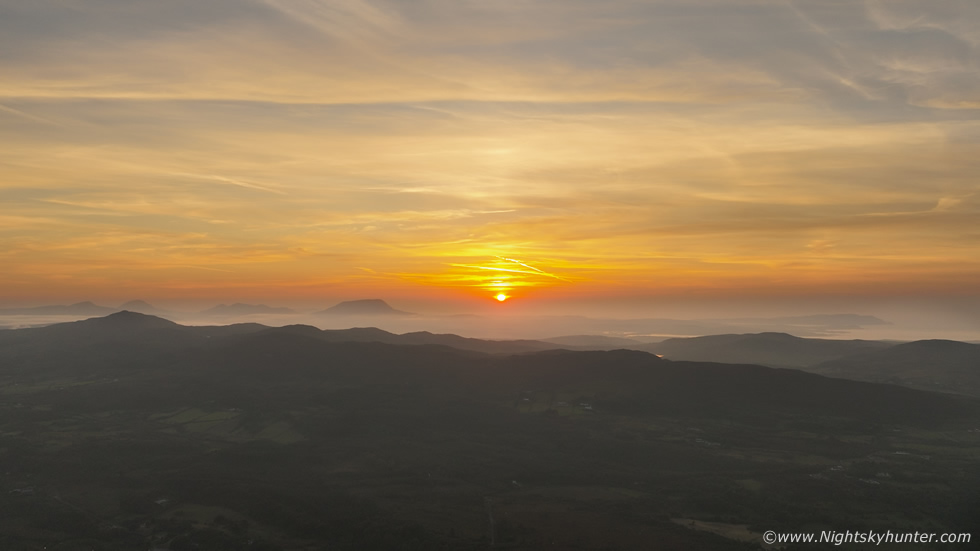 |
We only had a few minutes of daylight left so we sent the drones straight up for a look at the setting sun and what a gorgeous sight it was. The yellow disk of the sun was lowering into haze and above was a forming sun pillar. All this over dense sea mist and distant mountains of Donegal piercing through the mist. Finally the disk turned blood red then vanished into the horizon haze, it was a scenic end to the day which set our adventure off into high spirits. We were getting hungary and fancied something warm so we drove to a local village and ordered a take away.
Half an hour later we found a picnic spot looking across the lough with numerous islands, it was a perfect location to eat. Twilight was already waning and soon darkness had fallen. There was still some hazy high level cloud around but we knew this would vanish later, the important thing was plenty of stars were shinning. We ate our warm take away, Rhua had some of my chicken nuggets, then a hot brew. Paul had his van kitted out for staying overnight in so it had all the essentials for eating and drinking. We had fresh water boiled from the kettle, I can tell you that brew was a joy to drink, so warm it brought us back to life. After a few more snacks we felt ready for the night ahead, we then headed back to the boats with anticipation and excitement.
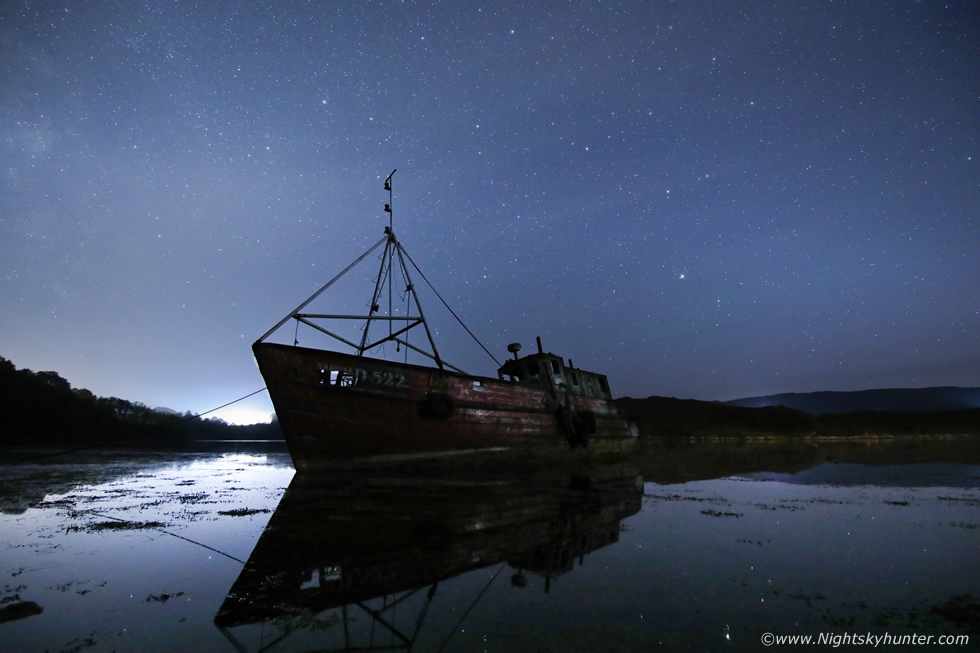 |
Sabrina was excellent, we were both falling in love with this boat, we also knew we would have to work it to make the images effective, however we had several problems this night. It was now high tide so the water level was higher, we couldn't walk out close to the boat. The other problem was the bright town lights which impacted the Milky Way potential due to light pollution. We suspected the high humidity was exaggerating that light though and it may not be as bad on a night of better transparency. High level haze/cloud also impacted the sky transparency so we were not getting as many stars as we should.
All that being said we are optimists, we still had stars and that's all we needed for tonight to test the location. Sabrina facing W-SW, the bright star to the lower right is Arcturus in Bootes. Close by to the E is Corona Borealis, I did a quick naked eye check and Blaze Star TCrB hadn't erupted yet. Further E was Ophiuchus and to the SW faint traces of the Milky Way could be seen through Aquila, Scutum and Sagittarius. One good thing about the high tide was getting stars reflecting in the water.
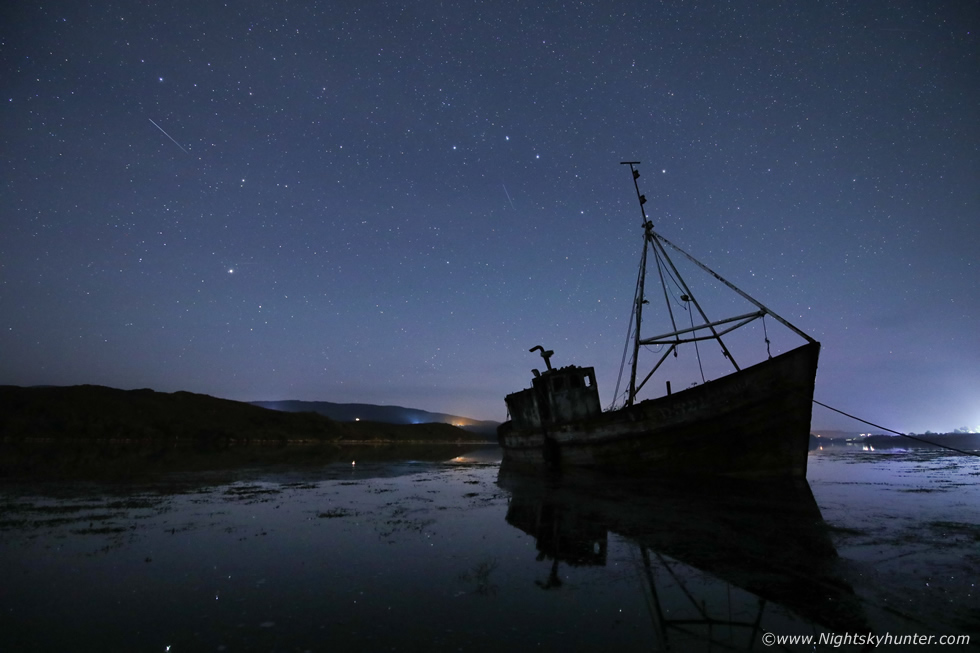 |
The other side of Sabrina facing N-NW, we really loved this angle, perfect for aurora and star trails. You can just make out traces of green airglow along with several passing satellites.
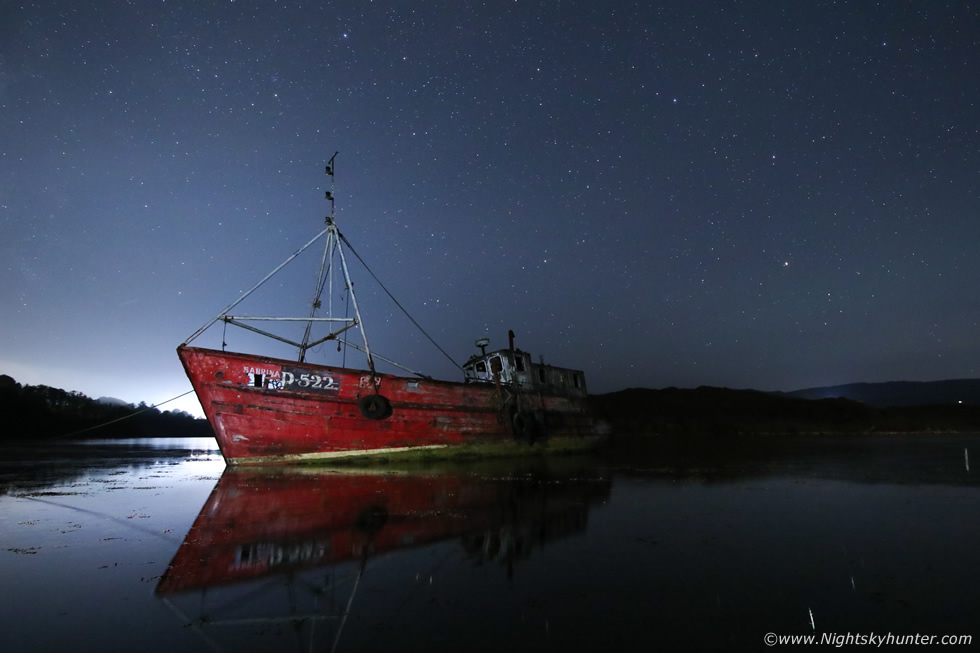 |
Paul used his phone light to illuminate the old boat for this exposure. That background town light was annoying us, had the tide been out we could have walked closer and used the boat to block the brightest part of the light. I began shooting a time lapse but after a while we decided to change plans. We loved it here but the timing wasn't correct yet. Paul suggested going to Fanad to check it out then come back here at low tide to get the images we wanted when everything would be perfect, I thought that was a great idea so we packed up and made our way to Fanad.
 |
25 min's later we arrived at Fanad Head, the sky was extremely dark and was devoid of any high level cloud, in fact, it was 100% clear and looked amazing. We wasted no time and got the gear ready, Rhua on her lead, then made our way over the headland with head torches until we reached the edge of the cliff. It was a great location and the lighthouse was fantastic however our earlier concerns had been correct. Several families where indeed staying over so we wouldn't be getting close, and worse, they had fitted outdoor lights around the outside of the building for health and safety and the lights were on. This ruined the potential at night quite a bit, we walked as far around the headland as we could so the walls would hide some of these lights and it was then we noticed another issue.
The light beam had changed, actually it seemed to us to be much brighter since we had last been here and the pulses were very frequent, we couldn't get the high ISO and/or long exposure images we wanted as they simply blew out. I wanted an image for the memories anyway so here's a wide angle short exposure with the sky recovered a little in post. Hyades, Pleiades, and planet Jupiter rising in the NE.
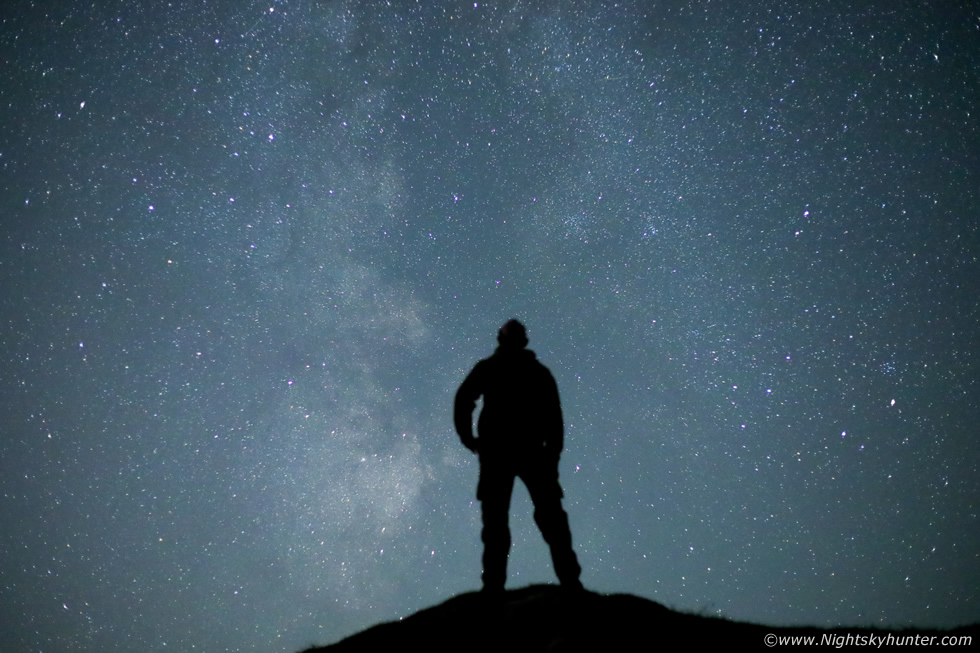 |
We where here for the Milky Way anyway so we focused our attention in that direction. I have to say the sky was stunning here, even darker than the dark sites I'm used to back home. The Milky Way (MW) looked like stationary mist or cloud perched among the stars, it wasn't just a glow, it had presence, almost solid in nature, especially the southern regions. I was eager to see what a 50mm F/1.8 lens on full frame would do here, so I aimed it at the region of sky towards Aquila, Scutum and the upper regions of Sagittarius, stopped the lens down to F/2.2, ISO6400 for 8 sec's. The detail was amazing, even for a single exposure untracked.
I thought this would be the perfect time for a selfie, something I haven't done in a long time. In the dark I spotted rising ground behind us so I walked onto the top of that and let the camera shoot on continuous mode, done a few poses, then came back down to check the results. I really liked this, just the MW and I from the darkest skies of Co. Donegal, this was easily my best image of the night. I'ts impossible to count the amount of stars in this image, the galactic dust clouds were striking, open cluster M11 can be seen to the left of my arm. Imagine how many suns lurk within this region of our galaxy, our MW contains at least 400 billion suns in total and this just a small section of our galaxy, and there are billions of galaxies in the observable universe. I wonder within this image how many intelligent civilizations live or have lived on planets around any of those stars.
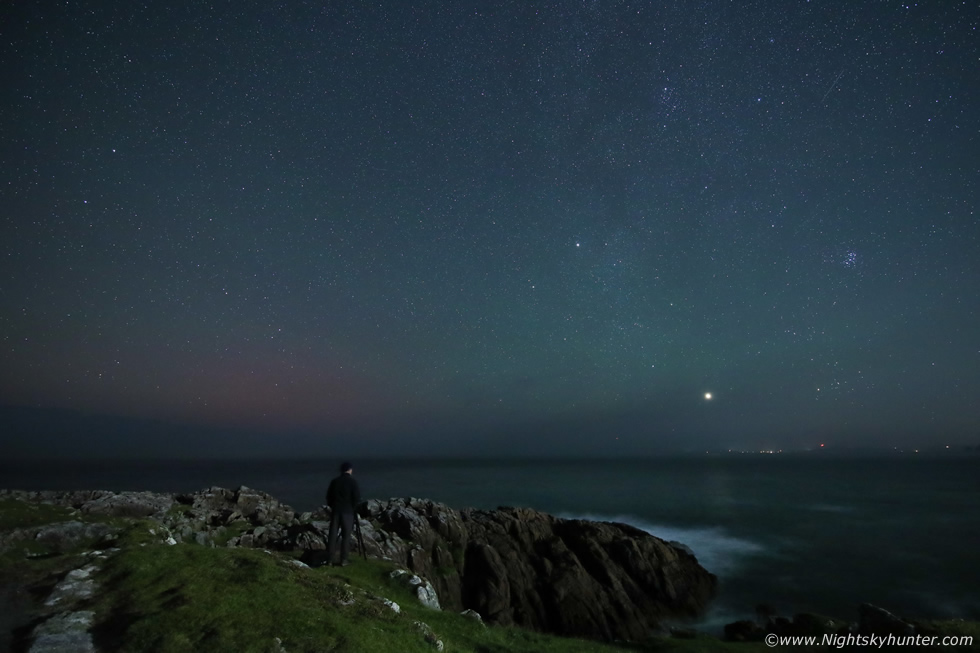 |
Often when Paul and I are shooting together we end up drifting apart lost in our own world following our instincts and internal compass. Paul began to drift off towards the edge of the cliff to the N and I began alternating between the MW in the SW and the stars of the N. A 15 second exposure out over the N Atlantic with Capella and Jupiter rising. Also note the presence of green airglow and a very subtle red glow from a faint aurora to the far N, you can also see a fainter segment of MW going through Auriga.
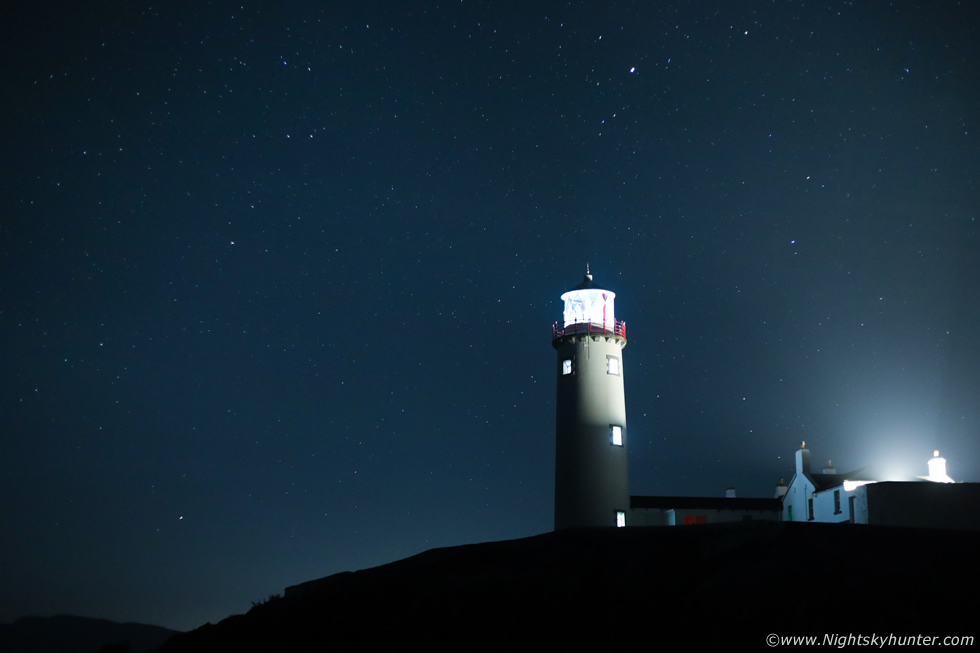 |
I decided to take one more image of the lighthouse using the 50mm fast lens to get a short of an exposure possible, I managed to just capture it between flashes from the beam. It would be quite awesome to stay there for a couple of nights.
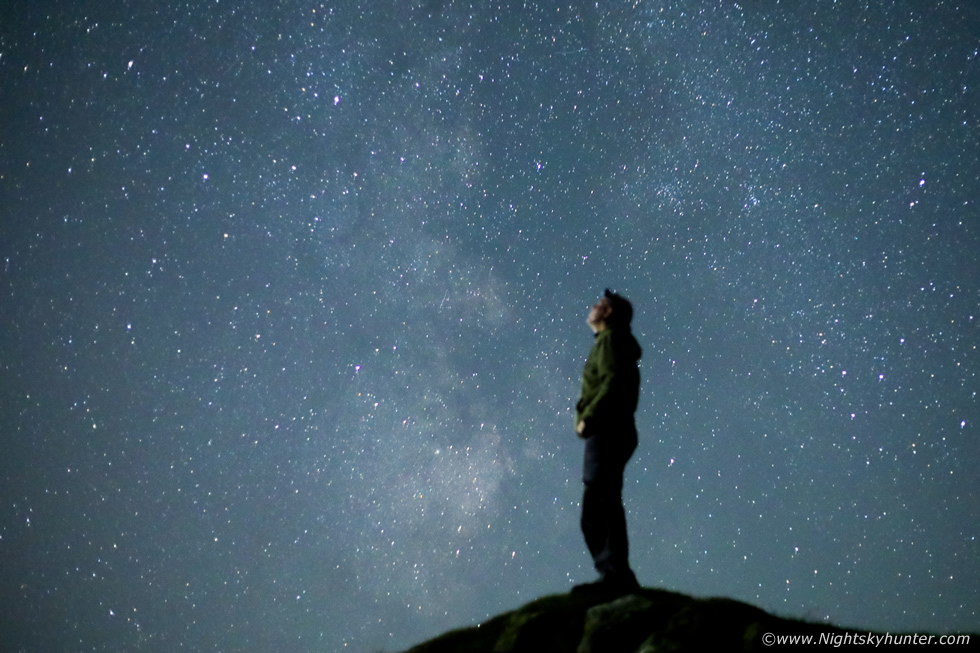 |
Another one of the selfie images, the ligh house beam illuminated me here, for some reason my tripod shook so the stars were slightly trailed here, however I actually like this image better than the first so decided to include it for the memories.
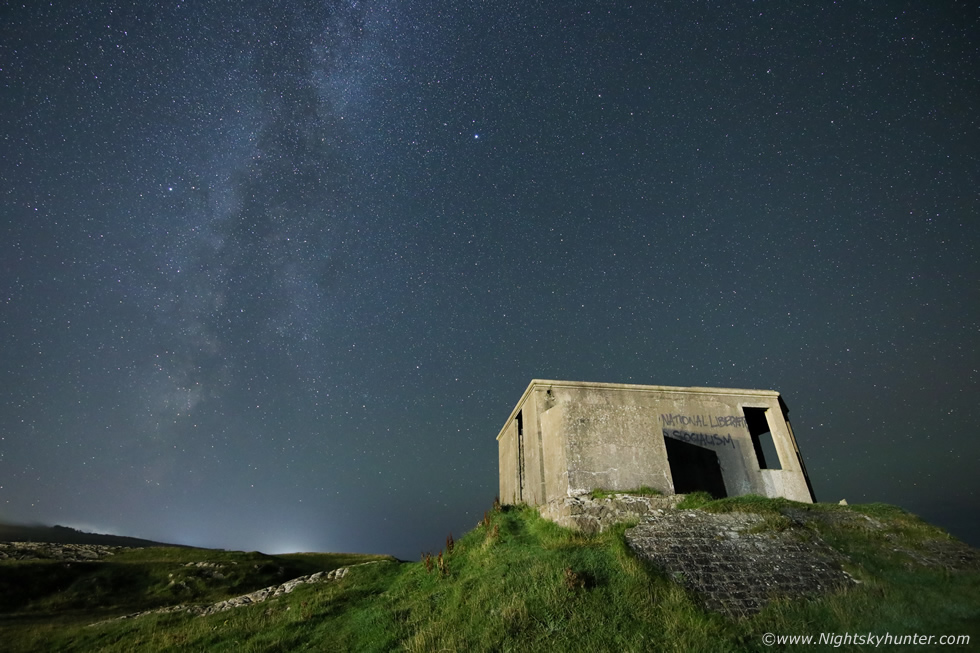 |
It was 01.00 in the morning, Rhua and I hiked across the rugged grass and rocky headland to see what else I could find, Paul was nowhere to be seen, he was doing his own thing. This is one of the old World War II look out posts where volunteers would spend days and nights watching over the sea for enemy ships and planes. There where many of them built across the coast, this was the closest outpost to the lighthouse. Can you imagine the thoughts in the observer's minds back then and what they were anticipating. They must also have seen stunning night skies and auroras in the process and lightning storms too. Back to 15mm wide angle here from Altair in Aquila downwards, airglow can still be seen to the right.
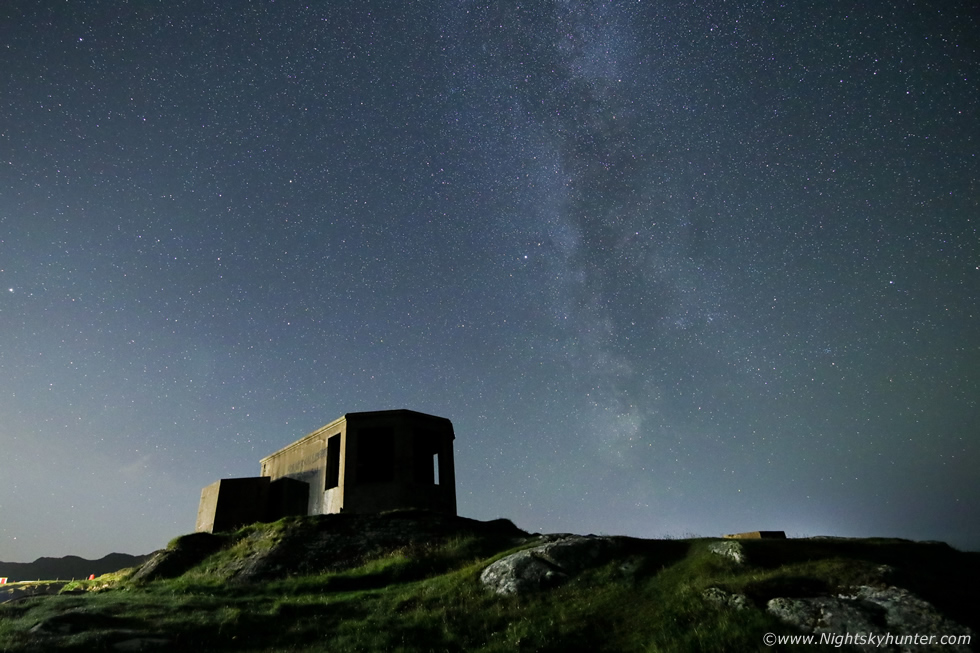 |
I spent a good hour working this one outpost trying different angles with the MW. The beam from the lighthouse did all the light painting for me which actually helped alot. MW and airglow blending in, the stars to the lower right just above the local horizon are in Sagittarius near the centre of our galaxy, hidden unseen far away in that direction is a black hole.
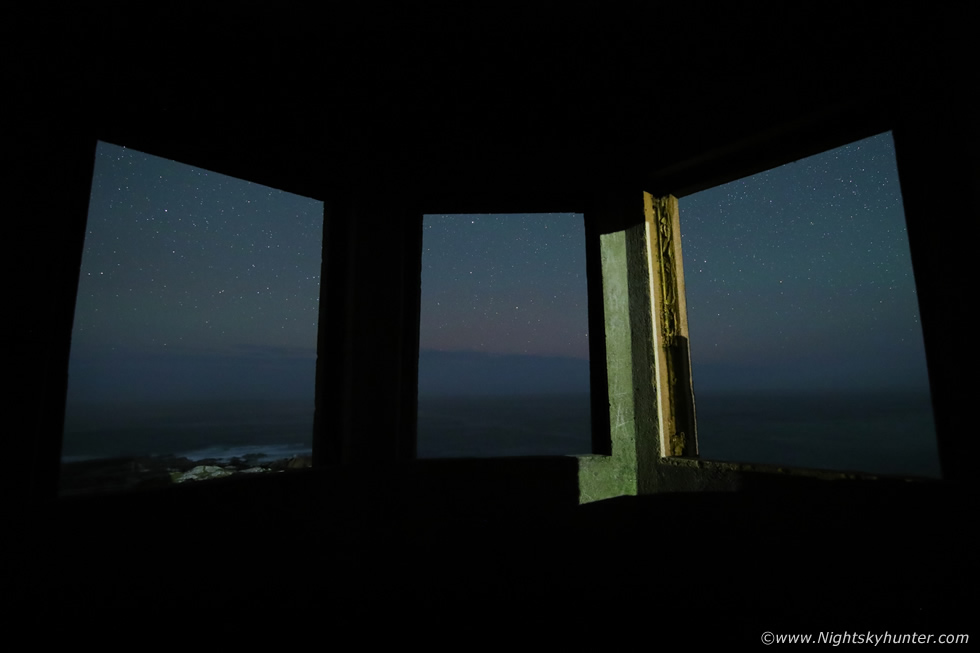 |
Rhua and I went into the look out post for an explore, it was very dark inside and a little creepy in a cool way, however the view outside was really something, the subtle green airglow was visible out the open windows to the N.
 |
A final image of the structure and MW before continuing on with the explore, this time with the 15-30mm F/2.8 lens at 24mm, 24 is a nice focal range, I would love a really fast fixed lens at this range for full frame, always a good scale for MW scenes. The sky here really was so dark it made me wonder about what a star tracker and imaging stacking could get, especially on a night with more exceptional clarity.
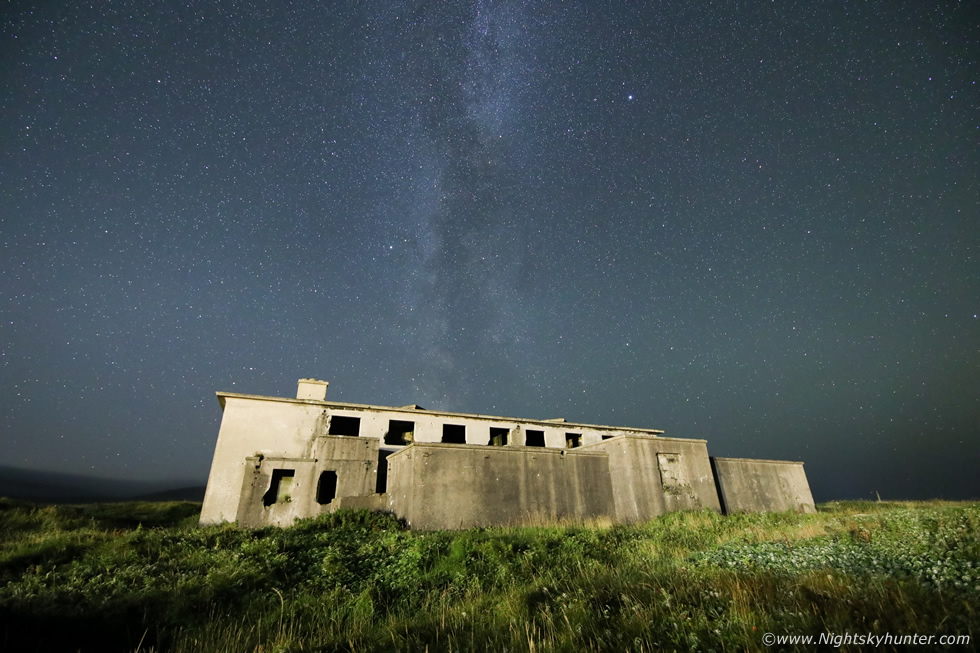 |
This was the largest structure on the headland with WWII associations, I shot it before in moonlight during my previous visit here but it would be a sin not to have another go. 15mm wide, note the slant of the building, that's not lens distortion, it's subsidence, the building is leaning down on one side. I always love finding old buildings to use for nightscapes.
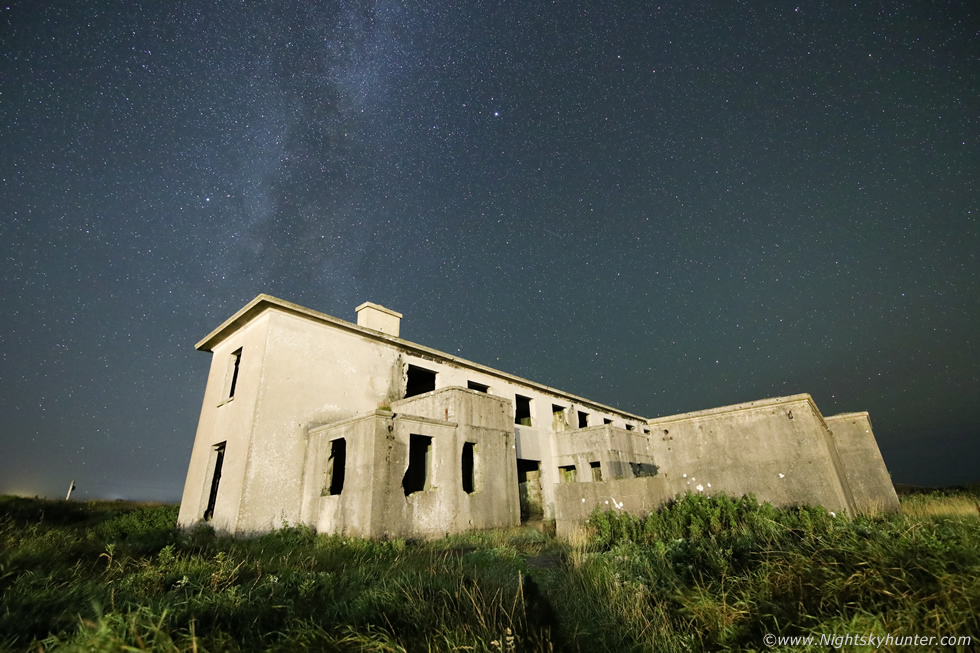 |
Up closer with tripod perched in the sketchy tall grass. It was 02.00 so Rhua and I made our way back to the van and 20 min's later Paul arrived from his own shoot, it was a nice couple of hours with the cameras. We both knew what we wanted to do next, go back to Sabrina, with a sky this good, better MW position and low tide we could get the images we really wanted so we got back on the road, tired but still buzzing with anticipation, I knew Paul was keen on a star trail there and I wanted a time lapse so this was shaping up to be a very late night indeed.
Literally five minutes down the road we entered dense sea mist, it covered everything, all over the road, fields, lough, sky covered, not even a single star visible, this was not expected. It was probably just this area and no doubt there would be clear breaks, but no, we arrived at the boat and there was nothing to see but dense grey mist. We had to call it a night, sat imagery showed everything closing in with mist and cloud, even inland, it was time to go home. At first we were frustrated we didn't get the boat images we wanted but on the other hand if we hadn't of went to Fanad, which was clear, we never would have got anything because Mulroy Bay had misted over early, had we stayed there we would have assumed everywhere was the same and never went to Fanad, so nice one Paul, that good feeling you had was bang on as always.
I arrived back in Cookstown for 04.30, it sure was a late night but I loved it. This was our first proper night shoot of the new season and it felt great to be back out checking exciting new locations. If anyone is ever in doubt about the darkest skies in the country visit Co. Donegal on a clear moonless night, the sky quality is exceptional, it really is a gem for astrophotographers and amateur astronomers and it should be cherished and protected at all costs. Paul and I, and my other friends, all look forward to returning again in the future for more photography adventures. If you have made it this far thanks very much for reading, my next report will be a photogenic local aurora hunt. It seems the night sky really is stealing the thunder this year and more major events are likely to come.
Martin McKenna